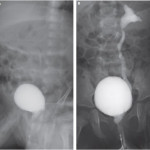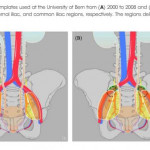Editorial: PLND during RP for PCa: extending the template in the right patients without increasing complications
It took long time and consistent evidence to endorse the staging role of extended pelvic lymph node dissection (PLND) in prostate cancer (PCa). The poor performance of both conventional and functional imaging in identifying preoperative nodal status has contributed to making extended PLND the most accurate nodal staging procedure in PCa 1.
Current available guidelines recommend a standard extended PLND template that includes external, internal iliac and obturator lymph nodes 2–4; however, where does the need for a more extended template originate? Observational data suggest that a standard extended PLND template intercepts ~75% of all anatomical landing sites 4. Extending the anatomical template by adding nearby nodal stations would further minimize the risk of missing positive lymph nodes; however, it has previously been shown that a more accurate staging (i.e. a more extended template) might come at the price of longer operating time and a higher risk of procedure‐related complications 1.
According to the study by Maderthaner et al. 5, in the current issue of BJUI, an experienced academic surgical team is able to further extend the PLND template (including common iliac and the fossa of Marcille lymph nodes) without significantly increasing the risk of complications. In their study, 17% and 7% of the included men with pN+ disease had positive common iliac and fossa of Marcille lymph nodes, respectively.
Before celebrating this super‐extended template as safe and effective, however, at least three points need to be considered. First, these results were obtained by a group of skilled surgeons with longstanding experience in anatomical pelvic nodal dissection. It should not be taken for granted that this template in the hands of other surgeons would result in no additional complications, especially during the learning curve.
Second, >80% of men submitted to the super‐extended template did not have positive nodes outside the standard extended template boundaries, indicating possible overtreatment in a substantial proportion of men. Notably, extended PLND in this study was offered apparently without upfront preoperative lymph node invasion risk stratification.
Third, as a consequence, patient selection has a role to play. In other words, is super‐extended PLND appropriate for every patient? The use of available risk stratification tools in everyday clinical practice allows a more accurate decision process; this is the case for the Briganti nomogram concerning the need to perform an extended PLND 6. Could a similar approach be used in the setting of a super‐extended template to identify the best candidates? Recently, Gandaglia et al. 7 analysed data from 471 men with high‐risk PCa treated with radical prostatectomy and a super‐extended PLND including common iliac and pre‐sacral nodes in order to identify those men who really require such a super‐extended PLND. Interestingly, although not specifically designed for this task, the Briganti nomogram was able to provide a patient selection strategy: only 5% of patients with a nomogram‐derived N+ risk of <30% had positive common iliac and pre‐sacral nodes, indicating that the super‐extended PLND template should perhaps be considered exclusively in men with an N+ risk ≥30%.
In conclusion, a critical assessment of super‐extended staging PLND template would be welcome, allowing selection of the proper candidates, and a proper balance between accurate staging and the risk of treatment‐related complications.
References
- 1 Fossati N, Willemse P‐PM, Van den Broeck T et al. The benefits and harms of different extents of lymph node dissection during radical prostatectomy for prostate cancer: a systematic review. Eur Urol 2017; 72: 84–109
- 2 Santis D, Henry A, Joniau S et al. Prostate Cancer EAU ESTRO SIOG Guidelines on 2017.
- 3 Mattei A, Fuechsel FG, Bhatta Dhar N et al. The template of the primary lymphatic landing sites of the prostate should be revisited: results of a multimodality mapping study. Eur Urol 2008; 53: 118–25
- 4 Joniau S, Van den Bergh L, Lerut E et al. Mapping of pelvic lymph node metastases in prostate cancer. Eur Urol 2013; 63: 450–8
- 5 Maderthaner L, Furrer MA, Studer UE, Burkhard FC, Thalmann GN, Nguyen DP. More extended lymph node dissection template at radical prostatectomy detects metastases in the common iliac region and in the fossa of Marcille. BJU Int 2018; 121: 725–31
- 6 Briganti A, Larcher A, Abdollah F et al. Updated nomogram predicting lymph node invasion in patients with prostate cancer undergoing extended pelvic lymph node dissection: the essential importance of percentage of positive cores. Eur Urol 2012; 61: 480–7
- 7 Gandaglia G, Zaffuto E, Fossati N et al. Identifying the candidate for super extended staging pelvic lymph node dissection among patients with high‐risk prostate cancer. BJU Int 2018; 121: 421–7



